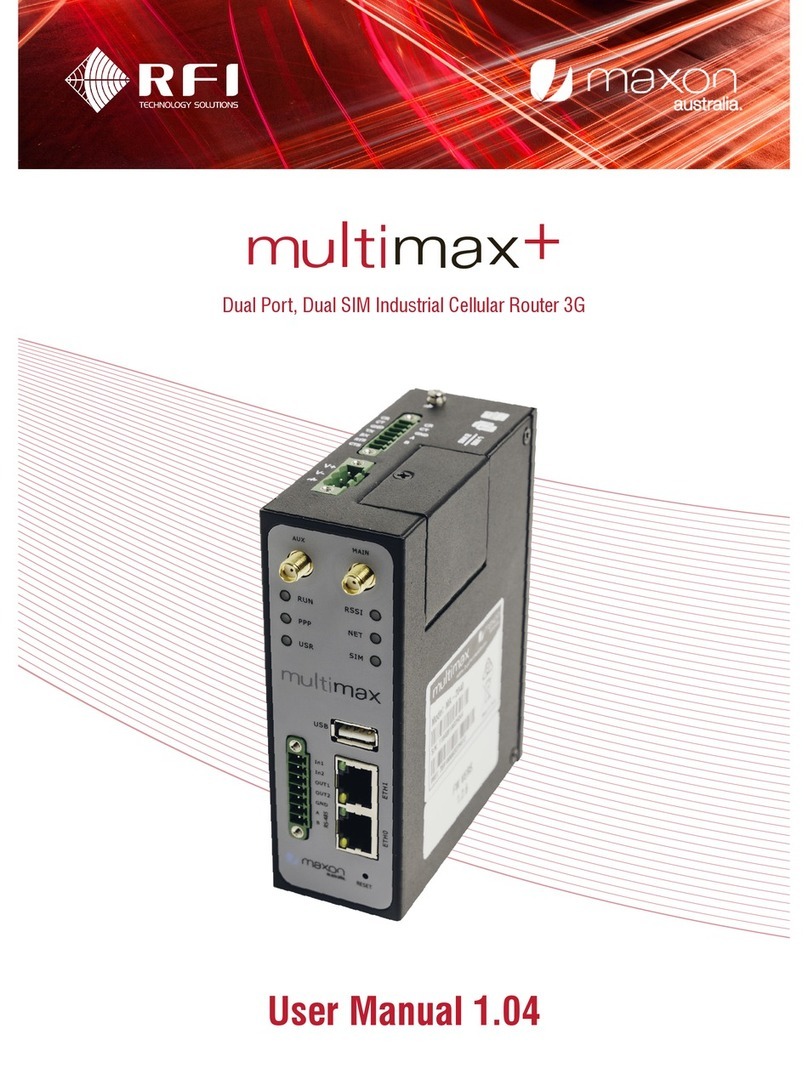
The information contained in this document is subject to change. This document contains proprietary information, which is protected by copyright
laws. All rights are reserved. No part of this document may be photocopied, reproduced or translated to another language or program language
without prior written consent of RFI Engineering B.V.
RefGuide_U-routerNGW_v1.01.docx Page: 1(57)
1 Table of Contents
2 INTRODUCTION .......................................................................................... 4
2.1 U-ROUTER NGW FEATURES ........................................................................... 4
2.2 U-ROUTER NGW VARIANTS ........................................................................... 4
3 CHECK YOUR PACKAGE CONTENTS .............................................................. 5
4 CONNECTORS AND STATUS LEDS ON THE U-ROUTER NGW.......................... 6
4.1 U-ROUTER NGW FRONT PANEL ....................................................................... 6
4.2 U-ROUTER NGW REAR PANEL ......................................................................... 6
4.3 ETHERNET PIN ASSIGNMENTS ......................................................................... 7
4.4 SERIAL PORT (RS232) PIN ASSIGNMENTS ......................................................... 8
4.5 EXPANSION PORT PIN ASSIGNMENTS ................................................................ 9
5 INSTALLATION OVERVIEW ....................................................................... 10
5.1 INSERTING THE SIM CARD .......................................................................... 10
5.2 CONNECTING POWER USING THE POWER ADAPTER ............................................... 11
5.3 CONNECTING POWER USING THE POEPOWER SUPPLY ........................................... 11
6 ACCESSING THE U-ROUTER NGW CONFIGURATION INTERFACE................ 12
6.1 CONSOLE LOGIN VIA SSH AND THE ETHERNET PORT (CLI) .................................... 12
6.2 LOGGING OUT (CLI) ................................................................................. 12
6.3 ACCESSING THE U-ROUTER NGW WEB GUI ..................................................... 13
7 DASHBOARD ............................................................................................. 14
7.1 SHOWING MOBILE CONNECTION INFORMATION................................................... 15
8 CONNECTING THE U-ROUTER NGW TO THE MOBILE NETWORK ................. 16
9 USER MANAGEMENT.................................................................................. 17
9.1 ADDING A NEW USER ................................................................................. 17
9.2 DELETING A USER ..................................................................................... 17
9.3 USER SHELLS .......................................................................................... 18
10 TIME SYNCHRONIZATION...................................................................... 19
11 CONNECTING EXTERNAL RELAY(S) TO THE EXPANSION PORT............... 20
11.1 USING A SLAVE REMOTE POWER SWITCH WITH THE U-ROUTER NGW ......................... 20
11.2 USING RS485 (RIOT) REMOTE POWER SWITCHES WITH THE U-ROUTER NGW ............ 22
11.3 LED INDICATORS ON THE RPSW ................................................................... 23
11.4 LAST RELAY POSITION IS SAVED IN THE EEPROM................................................ 23
12 CONNECTING TO CONSOLE PORTS OF REMOTE DEVICES ....................... 24
12.1 CONNECTING AN RS232 SERIAL CONSOLE PORT ................................................. 24
12.2 CONNECTING A USB CONSOLE PORT FOR CISCO DEVICES ...................................... 26
12.3 CONNECTING A USB CONSOLE PORT FOR JUNIPER DEVICES .................................... 28
12.4 ACCESSING THE CONSOLE INTERFACE OF THE CONNECTED DEVICE ............................ 30
12.4.1 Console Access from the >_Terminal tab in the Web GUI..................... 30
12.4.2 SSH login with a user that connects straight to the console port ........... 32
12.4.3 Console Access from Command Line: ngw-term.sh ........................... 33
12.4.4 Console Access from Command Line: minicom.................................. 34
13 CLI COMMANDS ..................................................................................... 35




























